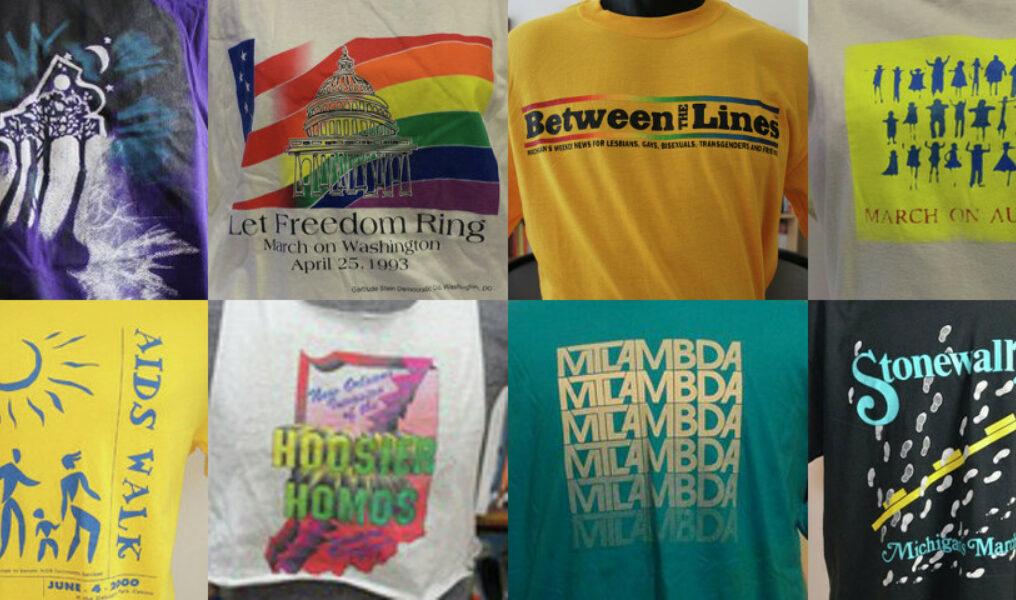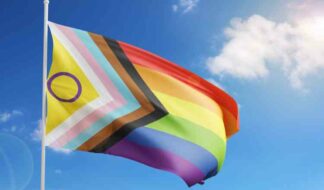Wearing Gay History Archive Showcases Thousands of Historical Shirts
Midwestern Historian
There is a perception by some that LGBTQ history didn't happen in the Midwest. And while it is true that many of the most notable LGBTQ-related events seemed to favor larger, more coastal cities across the U.S., there is certainly a wealth of history that can be found locally. That negative view of his homeland is exactly what Eric Gonzaba refused to believe when he was looking for a way to understand the Midwest's historical impact on the nation. That's why in college he began what would become the internationally-known Wearing Gay History T-shirt archive project.
"I come from a small town in the Midwest and the idea for this project came from the idea that there are gay people from Indiana and elsewhere," Gonzaba said. "I was in Washington D.C. and I was at this party. I was talking about it to someone who was there, an older gentleman, and I said I'd like to focus on queer history in the heartland. And he goes, 'Well, queer history didn't happen there.' It kind of infuriated me. So, what this project has taught me is how dynamic the community is and how diverse it is."
Gonzaba's project began while he was an undergraduate at school.
"I didn't know where to start," Gonzaba said. "I actually found my way to the Chris Gonzales Library and Archives in Indianapolis."
While at that LGBTQ history museum, he was hoping to find traditional documents to reference and perhaps start putting together a gay history exhibit of his own. That's when he stumbled upon a bunch of dusty unopened boxes.
"They hadn't been opened for a long time. I was going through them and it was just piles and piles of T-shirts from gay events in Indiana," Gonzaba said. "They were from bars, from bowling leagues, stuff and events, and I was fascinated by them."

Eric Gonzaba
Wearing History
Although T-shirts might seem like an unorthodox way to record history, the shirts have provided an unexpectedly efficient way of documenting the presence of LGBTQ-affirming people all across the world in recent history. And the answer is simple as to why: people love T-shirts.
Whether worn as an undershirt or simply as a standalone item, it's almost guaranteed that several T-shirts can be found in the average American closet. And the trend doesn't seem to be slowing down any time soon. In fact, bulk clothing retailer The Adair Group reported that in 2010 there were over 2 billion shirts sold globally — a trend that showed a more than 100 percent increase from 2005. However, although this clothing item made its mainstream debut sometime in the early 1900s, it wasn't until the late '60s and '70s that custom T-shirt printing really began to take off. And, as the modern LGBTQ equality movement began to gain its footing, so did the rise of LGBTQ-themed T-shirts.
These shirts — depending on their designs — could either boldly proclaim support for LGBTQ rights or serve as clandestine messages to members of the same groups long before social media and today's more inclusive climate. And, in this way, they serve as reliable evidence of LGBTQ events — before it was even safe to publicly hold them.
A Project's Beginnings
After sorting through the contents of those dusty, history-filled boxes, it didn't take long for Gonzaba to start putting together his own exhibit at school. It showcased a selection of his 20 favorite shirts, and each displayed designs from a variety of Indiana pride events, groups and organization. Yet, as big of a step as that was toward the project's current scale, the Indiana University exhibit didn't last very long.
"At the end of it, I took down the shirts, I took down the museum, the messages I had written with them," he said. "And no one ever saw it again."
It wasn't until Gonzaba started his graduate program at George Mason University just outside of Washington D.C. that he considered rekindling some of his forgotten work.
"When I was at George Mason I didn't know at the time that its history department is known for its digital history. It's for trying to understand history in a different way using digital technology," Gonzaba said.
That new approach to history got him thinking about creating a digitized version of his own unique history project, and was at the top of his list when he realized he needed to complete several large-scale assignments to advance his graduate degree. It turned out that the long-forgotten T-shirts were the right fit for Gonzaba.
"I was thinking that I'd fly back down to Indianapolis and photograph all the shirts in the collection. I wanted to make a very basic archive so that people could look back on these shirts if they wanted to, and it went well in the class," he said. "They liked it."
Eventually, the project grew to the proportions it has today.
"I went to Chicago and the Gerber/Hart Archives, their gay archives, and they had 300-or-so shirts. Then I went to Philadelphia to do their 300-or-so shirts and four or five years later there are now 20 collections from 20 archives around the world. There are now almost 5,000 shirts," Gonzaba said. "It expanded, and it got recognized by a few big organizations and it won a few awards."
Online Accessibility and Local Outreach
Today, the entire collection is documented on the project's website, wearinggayhistory.com. There, interested people can not only view a photo of the T-shirts housed in the archives around the world, but learn more about where each T-shirt can be found across the globe and its unique history. The online museum even includes a few accessories like hats.
Wearing Gay History also caught local attention too. Although the T-shirt project included many shirts from across the U.S., there were a few states like Michigan that were left out. Michigan-based LGBTQ historian and Michigan State University Professor Tim Retzloff said that Gonzaba's project was a perfect added element to his classroom instruction. He said he got inspired to contribute materials to the project when he noticed there weren't any contributions from Michigan.
"I know Michigan has a number of repositories that have collected LGBTQ materials going back to the 1960s, so it kind of bugged me that Michigan didn't associate with it," he said. "It kind of dovetailed into this class I was teaching which is a version of advanced women's studies that satisfies the LGBTQ studies minor. My focus, when I teach it, is that I'm doing queer history and in a variety of ways: From reading and writing, understanding narrative history and oral history, to understanding how historic preservation and recognizing historic sites might be a factor, to how archives are created and how museums might get material."
Gonzaba, having lived in Michigan for several years himself, said he was very open to gaining project contributions from Retzloff and from people across the globe who don't live in traditional hot spots of LGBTQ history.
"There's a different angle of gay history that we think of," Gonzaba said. "We think that there's a closet one day and then there's not a closet one day. There's a huge area, though, of where gay people have always been out and proud and that really inspired me."
Maurice Stepp is an openly gay MSU undergrad who majors in kinesiology. However, in search of adding to a self-described "passion project," he participated in Retzloff's class this past school year. Stepp said that the class's partial focus on the T-shirt project was a great way to connect him to LGBTQ history he didn't know about before.
"I personally took this class because I wanted to get to know my community and the people within it and I wanted to understand where we come from and where we're possibly going," Stepp said. "If you think about the LGBTQ community, you mostly think of major cities, coastal cities and not everyone is fully represented so these databases are able to collect things that are not only mainstream, but parts of different cultures and subcultures that are not as well-represented. I think that's the main important thing to take away from the databases."
Although Gonzaba does not house the T-shirts himself, to find out more about Wearing Gay History or how to donate to some of the various collections around the world, go to http://wearinggayhistory.com.










